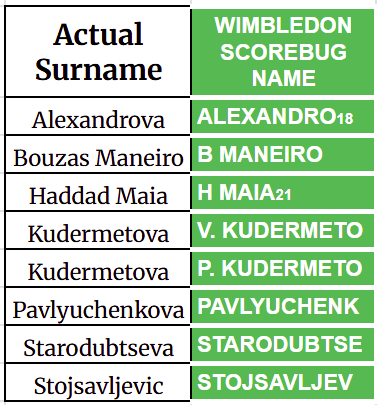What D-Fokina Is On Screen at Wimbledon?
At a place known for its precision, Wimbledon's broadcast scoreboards bug me.
WIMBLEDON, England — As I settled into to my desk at Wimbledon earlier this week, I was baffled by what I saw on my screen.
The two players on court, Botic van de Zandschulp and Alejandro Davidovich Fokina, were both represented in the Wimbledon World Feed’s scorebug—the television term for a score graphic that stays on screen throughout a sporting event—by remarkably chopped-up versions of their surnames: VAN DE ZAND and D-FOKINA.
I vaguely knew that Wimbledon had often taken some liberties with names on their scorebugs over the years, but this one-two punch jarred me more than the practice ever had before, and I set out trying to figure out if there was a method to their mangling madness.
As I clicked around the recordings of past matches, there didn’t seem to be any consistent methodology used. Even in Davidovich Fokina’s first match his name had been displayed differently, appearing as just “FOKINA.”
Then I started thinking back to Monday night here, when I was receiving texts from a couple friends about how well Taylor Fritz’s opponent was playing in what turned out to be a record-breaking performance. Those texts only referred to that player as “Perricard,” because that was the only part of Giovanni Mpetshi Perricard’s name that was consistently on the screen. So, understandably, those viewers thought “Perricard” was a normal way to refer to him.
But his surname, as I wrote it throughout my own piece, is Mpetshi Perricard.
Wimbledon is known for some vestigial quirks—like the all-white rule and even playing on grass—but this habit struck me as particularly odd. In no other part of the culture would we refer to the painter as T-LAUTREC, or the actress as L-DREYFUS, or the singer as N-JOHN, or the basketball players as G-ALEXANDER or A-JABBAR.
Deciphering the Wimbledon Recipes for Chopped Name Salad
Now curious, I went through all the long-ish names in the 2025 singles main draws, and found 20 distinct examples of how players names were truncated in various ways by Wimbledon this year.
I’ve separated this census into men’s and women’s tables:
Lengthy names get approached different ways here.
Ones that are one long word—like Alexandrova or Starodubtseva—get chopped off at the end. Even Basilashvili, which was only narrowly too wide, it seemed, was hacked into just “BASILASHVIL”.
Where it gets nuttier is when the surnames involve multiple words. Sometimes they just take the final word and use it as a standalone, turning Ugo Carabelli into “CARABELLI” or Bautista Agut into “AGUT.” For Spanish names in particular, the far more common practice is to use only the first (paternal) surname when not using the whole name, but Wimbledon has developed its own anachronistic methodology.
Other times, Wimbledon adds a letter from the first word in at the front as a hint that there’s more going on here, like turning Haddad Maia into “H MAIA” or Pinnington Jones into “P-JONES,” the latter of which involves the insertion of a phantom hyphen. Pinnington Jones, as you can see, won a round, so his name got to experience both methods.
This is all very strange mostly because, to state the obvious, it’s not hard to fit a long name’s worth of letters onto a television screen. The technology to make a letter or word narrower to fit within space constraints has existed, probably, roughly as long as the written word itself.
Sure enough, when I started digging a little deeper into this by looking at last week’s Wimbledon qualifying draws, I saw that they had known how to do this during that week, even with some far more unwieldy names than were in the main draw.
Andorra’s Victoria Jiménez Kasintseva got both of her surnames—and a two-digit seeding— onto the scorebug in full during qualifying.
The producers of the qualifying matches even managed to fit the entire 26-character surname of Spanish player Guiomar Maristany Zuleta de Reales onto the scorebug for her match.
It can be done! This technology to make letters narrower exists!
After I tweeted out the VAN DE ZAND vs D-FOKINA scoreboard on Thursday, it seemed like maybe someone in the Wimbledon production team had gotten the memo to shape up, because names started appearing in full the rest of that day, with narrower font.
Not only was there adequate room for the first round’s BASILASHVIL to become BASILASHVILI, even Jessica Bouzas Maneiro—who had been “B MANEIRO” in the first round—got to be in her full “BOUZAS MANEIRO” glory as she hit nine aces in her second round upset win over Sofia Kenin.
But there was some regression to the norm on Friday: Davidovich Fokina was back in action, this time on Centre Court, where he was once more the baffling D-FOKINA.
This Centre Court match was also on ESPN, and when I looked at their feed, I was impressed by what seemed, by Wimbledon standards, like highly advanced technology. In roughly the same amount of pixels, ESPN managed to include both of Davidovich Fokina’s surnames, his seed, a flag, and even a country code—which, honestly, felt like showing off since it was redundant with the flag.
An Explanation From the A-Club
When I asked the communications department of the All-England Lawn Tennis Club for an explanation of this befuddling broadcast graphics practice, they took nearly 24 hours to figure out how to explain what they had been doing; this wasn’t a question they seemed to have ever addressed before.
Here’s what the AELTC said in their statement:
We are limited on the top score to the number of characters we can include (particularly if adding their seeding), and with excessively long names, often double-barrelled, it’s not always possible to spell out the full name.
Attention is given to ensure that if the name needs to be shortened, that it a) it makes sense, and b) that it reads naturally.
For double-barrelled surnames that cannot be spelt in full, we use the initial of the first name, then a hyphen, followed by the full spelling of the second name.
What is possible on some occasions, is to slightly ‘squash’ the letters to include the full name.
Because of how inconsistent the examples I’d found were, I wasn’t left satisfied by the statement. I don’t think their methods shortening—e.g., “Haddad Maia” to “H MAIA”—make sense. It also wasn’t clear why it wasn’t possible to “squash” letters on all occasions, or why the shortening of multi-word names was so inconsistent and unpredictable.
Though my question was new, the practice is not: Wimbledon has been displaying names in a way that would defy external logic for a long time now, at least a couple decades.
I looked back at the Maria Sharapova’s star-making victory over Serena Williams in the 2004 final, and saw that her big win—which brought in millions in endorsements—came with one letter embargoed on Wimbledon’s production.
And then some of the players who I tracked in 2025 had been chopped up differently in years past: for example, 2025’s “VAN DE ZAND” had just been “ZANDSCHULP” in 2022; not that anyone is probably only following tennis this way, but I don’t think it would be easy to realize that “VAN DE ZAND” and “ZANDSCHULP” are even the same person.
How PAVLYUCHENK, D-FOKINA, and B MANEIRO Felt
None of the players are watching their matches on TV as they play them, of course, but I was still curious what they thought about this situation.
When I told Anastasia Pavlyuchenkova—who has heard jokes about her long name throughout her career—that Wimbledon included her full name on the scorebug in her win Friday over Naomi Osaka instead of just PAVLYUCHENK as it had been in the first round, she responded with some light sarcasm.
“Wow, very appreciated,” Pavlyuchenkova said, clearly happier about other aspects of her day. “I didn’t notice, but I’m used to it and I don’t mind. Even chair umpires sometimes, they can’t pronounce my name during a whole match, still making mistakes. I’m very chill about it.”
When I showed Alejandro Davidovich Fokina—aka FOKINA, aka D-FOKINA—the various ways his name had appeared at this tournament and asked him if he had a preference, he also didn’t seem overly concerned.
“Maybe they just put ‘Foki,’” he said, using his common nickname among other players. “It can be ‘Foki’ only. But I don’t care which one.”
When I showed Jessica Bouzas Maneiro her first round appearance as “B MANEIRO,” she made a sudden “ooohhh” sound.
“I have never seen it like that,” Bouzas Maneiro said of her deouzasing.
Normally, when her name is shortened in Spain, it goes down to being just Jessica Bouzas, using only her paternal surname.
“But I like that my mom’s name is there too,” she said of her Maneiro.
As I was leaving the room, I could hear Bouzas Maneiro discussing it further with the Spanish reporter who was going to talk to her next.
“‘B Maneiro’—que raro,” they said, meaning: “How odd.”
Given how precise and polished Wimbledon prides itself on being, I do think these slapdash renderings of names—particularly ones that aren’t formed in ways common to British eyes and ears—speaks to a certain cultural insensitivity here. You would never see “D-FOKINA” or “B MANEIRO” on any screen in Spain; why is it good enough to pass muster in England?
A Way to Go
As I was working on this piece, I thought back to the draw ceremony last week, at which tournament referee Denise Parnell read aloud the names of all 256 players.
It’s not an easy task to have to pronounce all those names from around the world—I sympathize particularly as someone who was never wholly confident in his pronunciations of “Majchrzak” this week. But still there were a few howlers that drew muted giggles from the room, most memorably Parnell’s jaunty announcement of “You’re on your way!” when drawing the name of Chinese player Yuan Yue. “You’re on your way!” became something of a punchline among reporters the rest of the day as we passed one another in the corridors.
For sure, Yuan’s name is not the easiest to a non-native speaker of Chinese, as you can hear from her saying it on the WTA website.
But if you’re making a good-faith effort, it’s definitely not “You’re on your way.”
With that example in mind, I was touched when I saw a video that has been circulating on Chinese social media: Anna Blinkova, the France-based Russian who played doubles with Yuan here at Wimbledon, has been learning Chinese in order to better speak to a group on tour that is often isolated due to language barriers.
If Anna Blinkova can put in the time and energy to make an effort for a foreign group of players, surely Wimbledon can do the same. And when it comes to scoreboards, I’d like it if next year everyone is in the appropriately narrow font from the beginning. Hopefully, Wimbledon, you’re on your way.
Thanks for reading Bounces! Beyond the paywall below for Bounces subscribers, a look at four Day 6 Matches to Watch. -Ben






















